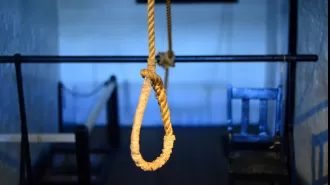Boeing's malfunctioning spacecraft returns to Earth with 2 astronauts still in orbit.
Boeing's first astronaut mission ended with an empty capsule landing in New Mexico, leaving two test pilots in space until next year due to risk.
September 7th 2024.

Boeing's first astronaut mission in partnership with NASA came to an uneventful end on Friday night. The Starliner capsule, carrying two test pilots, landed in White Sands Missile Range in New Mexico after a six-hour journey from the International Space Station. The landing was controlled by the capsule's autopilot system, and it marked the end of a dramatic mission that had been riddled with technical issues and delays.
The journey began in June with the launch of Starliner's first crewed mission, which was long overdue. However, the mission quickly turned into a nail-biting cliffhanger as the capsule experienced thruster failures and helium leaks. Engineers worked tirelessly to understand and fix the problems, and for months, the return of test pilots Butch Wilmore and Suni Williams was uncertain.
Boeing was confident in their extensive testing and declared the Starliner safe for the pilots' return. However, NASA had their doubts and decided to book a flight with SpaceX instead. This means that Wilmore and Williams will have to wait until the end of this month to return to Earth, making their trip last for over eight months instead of the intended quick trip.
The original plan was for Wilmore and Williams to return to Earth a week after launching in the Starliner. However, their journey to the space station was plagued with issues, and NASA deemed it too risky to bring them back in the same capsule. So, the Starliner returned to Earth with empty seats, blue spacesuits, and some old station equipment after receiving software updates.
As the capsule undocked from the space station and disappeared into the darkness over China, Williams radioed, "She's on her way home." This marked the end of a challenging journey for the Starliner, which had been delayed and had encountered multiple setbacks. After the retirement of the space shuttles, NASA had hired Boeing and SpaceX for orbital taxi services. However, Boeing's first test flight in 2019 had so many issues that it had to be repeated, and the 2022 do-over uncovered even more flaws, leading to a repair bill of over $1 billion.
Meanwhile, SpaceX has successfully completed nine crew ferry flights for NASA since 2020, with the next one scheduled for later this month. The Dragon capsule will launch with only two astronauts on board, as the other two seats are reserved for Wilmore and Williams for their return journey. Both astronauts, being experienced and retired Navy captains, were prepared for challenges on this test flight and have been busy helping with repairs and experiments on the space station. They are now full-time crew members, along with seven others on board.
Before the launch in June, Starliner's propulsion system had already shown signs of trouble with a small helium leak. Unfortunately, four more leaks occurred after liftoff, and five thrusters failed during the mission. While four thrusters were eventually recovered, the situation was concerning for NASA as they were unsure if more malfunctions would occur during the capsule's descent from orbit.
Boeing conducted numerous tests to assure NASA that the thrusters were safe for the astronauts' return. However, the space agency remained cautious and chose to go with SpaceX instead. Even after undocking, flight controllers conducted further tests on the thrusters, and one of them failed to ignite. Engineers suspect that the thrusters may overheat with repeated use, causing protective seals to swell and block the flow of propellant. Unfortunately, they will not be able to examine the affected parts as they were jettisoned before reentry.
Steve Stich, NASA's commercial crew program manager, mentioned earlier this week that the teams were solely focused on the safe return of the Starliner and had not yet thought about what's next for Boeing. However, the space agency remains committed to having two competing companies for their space missions.
The journey began in June with the launch of Starliner's first crewed mission, which was long overdue. However, the mission quickly turned into a nail-biting cliffhanger as the capsule experienced thruster failures and helium leaks. Engineers worked tirelessly to understand and fix the problems, and for months, the return of test pilots Butch Wilmore and Suni Williams was uncertain.
Boeing was confident in their extensive testing and declared the Starliner safe for the pilots' return. However, NASA had their doubts and decided to book a flight with SpaceX instead. This means that Wilmore and Williams will have to wait until the end of this month to return to Earth, making their trip last for over eight months instead of the intended quick trip.
The original plan was for Wilmore and Williams to return to Earth a week after launching in the Starliner. However, their journey to the space station was plagued with issues, and NASA deemed it too risky to bring them back in the same capsule. So, the Starliner returned to Earth with empty seats, blue spacesuits, and some old station equipment after receiving software updates.
As the capsule undocked from the space station and disappeared into the darkness over China, Williams radioed, "She's on her way home." This marked the end of a challenging journey for the Starliner, which had been delayed and had encountered multiple setbacks. After the retirement of the space shuttles, NASA had hired Boeing and SpaceX for orbital taxi services. However, Boeing's first test flight in 2019 had so many issues that it had to be repeated, and the 2022 do-over uncovered even more flaws, leading to a repair bill of over $1 billion.
Meanwhile, SpaceX has successfully completed nine crew ferry flights for NASA since 2020, with the next one scheduled for later this month. The Dragon capsule will launch with only two astronauts on board, as the other two seats are reserved for Wilmore and Williams for their return journey. Both astronauts, being experienced and retired Navy captains, were prepared for challenges on this test flight and have been busy helping with repairs and experiments on the space station. They are now full-time crew members, along with seven others on board.
Before the launch in June, Starliner's propulsion system had already shown signs of trouble with a small helium leak. Unfortunately, four more leaks occurred after liftoff, and five thrusters failed during the mission. While four thrusters were eventually recovered, the situation was concerning for NASA as they were unsure if more malfunctions would occur during the capsule's descent from orbit.
Boeing conducted numerous tests to assure NASA that the thrusters were safe for the astronauts' return. However, the space agency remained cautious and chose to go with SpaceX instead. Even after undocking, flight controllers conducted further tests on the thrusters, and one of them failed to ignite. Engineers suspect that the thrusters may overheat with repeated use, causing protective seals to swell and block the flow of propellant. Unfortunately, they will not be able to examine the affected parts as they were jettisoned before reentry.
Steve Stich, NASA's commercial crew program manager, mentioned earlier this week that the teams were solely focused on the safe return of the Starliner and had not yet thought about what's next for Boeing. However, the space agency remains committed to having two competing companies for their space missions.
[This article has been trending online recently and has been generated with AI. Your feed is customized.]
[Generative AI is experimental.]
0
0
Submit Comment





